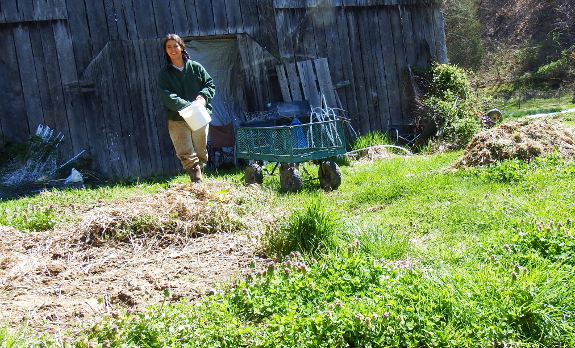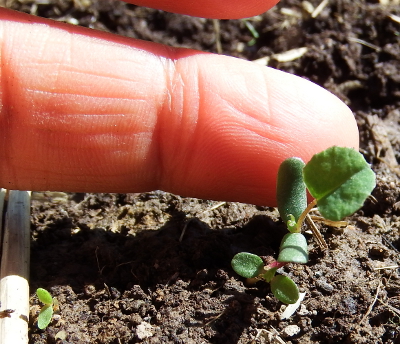
Mixing oats and clover

Over the winter, I
took topsoil from the beds close to the barn and the woods on either
end of the mule garden and created a new bed in a sunnier spot. That
left me with several patches of bare subsoil which are kinda-sorta an
erosion risk. Not really since they're surrounded by solid sod...but the
bare patches still offended my ecologist's eye. So I decided to seed
them in goat-fodder crops so Artemesia and kid(s) can graze in the shade
while I weed the mule garden. Sounds like paradise in the making,
right?
 I
started by sprinkling some leftover clover seeds that I'd bought for
the pasture last fall into the bare patches. I could have put in grass
seeds along with the clover, but I didn't want to wait so long for grass
to get established. So instead, I waited until the first true leaves
came out of the clover seedlings, then I added oats to the mix. (I make
this sound intentional --- actually, it took us that long to get to the
feed store and pick up the grain.)
I
started by sprinkling some leftover clover seeds that I'd bought for
the pasture last fall into the bare patches. I could have put in grass
seeds along with the clover, but I didn't want to wait so long for grass
to get established. So instead, I waited until the first true leaves
came out of the clover seedlings, then I added oats to the mix. (I make
this sound intentional --- actually, it took us that long to get to the
feed store and pick up the grain.)
Will the fast-growing
oats overpower the slow-growing clover and make the legume seeding
worthless? Will spring oats suit our goats' palates as well as fall oats
do? You'll have to come back this summer to check out the answer to
this nail-biting, homesteading cliffhanger.
Want more in-depth information? Browse through our books.
Or explore more posts by date or by subject.
About us: Anna Hess and Mark Hamilton spent over a decade living self-sufficiently in the mountains of Virginia before moving north to start over from scratch in the foothills of Ohio. They've experimented with permaculture, no-till gardening, trailersteading, home-based microbusinesses and much more, writing about their adventures in both blogs and books.
Want to be notified when new comments are posted on this page? Click on the RSS button after you add a comment to subscribe to the comment feed, or simply check the box beside "email replies to me" while writing your comment.

For once I know something about this!
Anna, growing up in God's Country (Minnesota lol!) alfalfa and clover were grown for hay and haylage (hay chopped green and put up in a silo to ferment, cattle feed) and it was customary to plant these crops along with Oats as a "nurse crop". As the tender shoots of Alfalfa or clover would quickly get over run with weeds.
Crops were seeded in a grain drill, which essentially sows the seed in tiny rows a couple inches apart that become a solid stand. The seeds were in separate bins with separate seed meachanisms, as the way the seeding mechanism works the hole big enough for oats to go through would quickly over seed the tiny alfalfa or clover seed.
The oats would grow quickly and shade the alfalfa until it got established. In the upper Midwest climate, the oats (or barley or such) would mature and be harvested for the grain in late summer. The next season you would have a good stand of alfalfa.
So to answer your question, I think that after the oats mature you can mow them down and you will find the clover will spring up from the stubble.